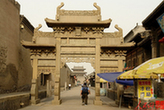Guqin, also called the seven-stringed zither, is China's oldest stringed instrument with a history of some 3,000 years. Its profound knowledge and its deep influence on Chinese people made it one of the greatest treasures in Chinese culture.
Guqin music is calm, simple, soft, and elegant in style. Yet, it is often misinterpreted by those first-listeners as motionless. In fact, Guqin music sounds most wonderful in the dead of night, when its peaceful beauty is given a vivid display.
To understand this music fully, one should not simply pay attention to its tunes, but comprehend it on spiritual level as well. Guqin music is formed and evolved under the deep influence of both Confucianism and Daoism. It values elegant and orthodox music while demeaning folksongs and obscene music. This well reflects the Confucian doctrine of mean and morality. At the same time, it also pursues the ideal of dao based on Lao Zi's philosophy. This is embodied in the charm of this music, which is simple, extricated, and edifying.
In fact, the spirit of Guqin music gives expression to the soul of the Chinese nation. It, together with other national treasures of China, adequately reflects the true composition of the people and the culture. No matter literary classics, music, or painting, they all possess a unique soul, i.e., the soul of China. So it’s not hard for one to witness the essential charm and beauty of Guqin music in the traditional Chinese paintings of all ages.
East Jin Dynasty (317-420) Gu Kaizhi Zhuo Qin Tu
Original (East Jin Dynasty) Copy (Song Dynasty) Silk scroll colored, Length: 130cm Width: 29.4cm Preserved in the Palace Museum |
Zhuo Qin Tu depicts the scene of making Guqin. There are 14 characters in the painting. Most of them are intellectuals. They have serious and dignified appearance. Their gowns are portrayed with fine lines. The elegance of Guqin is well embodied in the integral atmosphere of the painting.
North Qi Dynasty (550-577) Yang Zihua Jiao Shu Tu
Silk scroll Colored Length:122.7cm Width: 29.3cm Preserved in Museum of Fine Art, Boston |
It is recorded in Hua Ji (written by Huang Tingjian) and Dong Guan Shi Hua (written by Huang Bosi) that Jiao Shu Tu has two copies in Song Dynasty: sketched and colored ones. The painting depicts the scene that in 556BC Wen Xuan Emperor asked Fan Xun and some others to revise the records and stories in documentations such as Wu Jing. In the center of the painting, there are five officials, thinking, reading, walking, or writing. Besides them, the maids are playing Guqin peacefully. Through the fine lines, Yang Zihua creates an atmosphere of elegance in this painting.





Why not rent a boyfriend, or girlfriend to please parents during the Spring Festival?